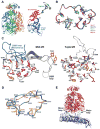Diversity-generating Retroelements in Phage and Bacterial Genomes
- PMID: 26104433
- PMCID: PMC4498404
- DOI: 10.1128/microbiolspec.MDNA3-0029-2014
Diversity-generating Retroelements in Phage and Bacterial Genomes
Abstract
Diversity-generating retroelements (DGRs) are DNA diversification machines found in diverse bacterial and bacteriophage genomes that accelerate the evolution of ligand-receptor interactions. Diversification results from a unidirectional transfer of sequence information from an invariant template repeat (TR) to a variable repeat (VR) located in a protein-encoding gene. Information transfer is coupled to site-specific mutagenesis in a process called mutagenic homing, which occurs through an RNA intermediate and is catalyzed by a unique, DGR-encoded reverse transcriptase that converts adenine residues in the TR into random nucleotides in the VR. In the prototype DGR found in the Bordetella bacteriophage BPP-1, the variable protein Mtd is responsible for phage receptor recognition. VR diversification enables progeny phage to switch tropism, accelerating their adaptation to changes in sequence or availability of host cell-surface molecules for infection. Since their discovery, hundreds of DGRs have been identified, and their functions are just beginning to be understood. VR-encoded residues of many DGR-diversified proteins are displayed in the context of a C-type lectin fold, although other scaffolds, including the immunoglobulin fold, may also be used. DGR homing is postulated to occur through a specialized target DNA-primed reverse transcription mechanism that allows repeated rounds of diversification and selection, and the ability to engineer DGRs to target heterologous genes suggests applications for bioengineering. This chapter provides a comprehensive review of our current understanding of this newly discovered family of beneficial retroelements.
Figures






Similar articles
-
DGR mutagenic transposition occurs via hypermutagenic reverse transcription primed by nicked template RNA.Proc Natl Acad Sci U S A. 2017 Nov 21;114(47):E10187-E10195. doi: 10.1073/pnas.1715952114. Epub 2017 Nov 6. Proc Natl Acad Sci U S A. 2017. PMID: 29109248 Free PMC article.
-
Accelerated Evolution by Diversity-Generating Retroelements.Annu Rev Microbiol. 2022 Sep 8;76:389-411. doi: 10.1146/annurev-micro-030322-040423. Epub 2022 Jun 1. Annu Rev Microbiol. 2022. PMID: 35650669 Review.
-
Target site recognition by a diversity-generating retroelement.PLoS Genet. 2011 Dec;7(12):e1002414. doi: 10.1371/journal.pgen.1002414. Epub 2011 Dec 15. PLoS Genet. 2011. PMID: 22194701 Free PMC article.
-
Diversity-generating retroelement homing regenerates target sequences for repeated rounds of codon rewriting and protein diversification.Mol Cell. 2008 Sep 26;31(6):813-23. doi: 10.1016/j.molcel.2008.07.022. Mol Cell. 2008. PMID: 18922465 Free PMC article.
-
Diversity-generating retroelements.Curr Opin Microbiol. 2007 Aug;10(4):388-95. doi: 10.1016/j.mib.2007.06.004. Epub 2007 Aug 20. Curr Opin Microbiol. 2007. PMID: 17703991 Free PMC article. Review.
Cited by
-
Phages infecting Faecalibacterium prausnitzii belong to novel viral genera that help to decipher intestinal viromes.Microbiome. 2018 Apr 3;6(1):65. doi: 10.1186/s40168-018-0452-1. Microbiome. 2018. PMID: 29615108 Free PMC article.
-
First crAss-Like Phage Genome Encoding the Diversity-Generating Retroelement (DGR).Viruses. 2020 May 22;12(5):573. doi: 10.3390/v12050573. Viruses. 2020. PMID: 32456083 Free PMC article.
-
Using Genomics to Decipher the Enigmatic Properties and Survival Adaptation of Candidate Phyla Radiation.Microorganisms. 2023 May 7;11(5):1231. doi: 10.3390/microorganisms11051231. Microorganisms. 2023. PMID: 37317205 Free PMC article. Review.
-
Mechanisms of viral mutation.Cell Mol Life Sci. 2016 Dec;73(23):4433-4448. doi: 10.1007/s00018-016-2299-6. Epub 2016 Jul 8. Cell Mol Life Sci. 2016. PMID: 27392606 Free PMC article. Review.
-
Selective Isolation of Eggerthella lenta from Human Faeces and Characterisation of the Species Prophage Diversity.Microorganisms. 2022 Jan 17;10(1):195. doi: 10.3390/microorganisms10010195. Microorganisms. 2022. PMID: 35056644 Free PMC article.
References
-
- Agrawal A, Eastman QM, Schatz DG. Transposition mediated by RAG1 and RAG2 and its implications for the evolution of the immune system. Nature. 1998;394:744–751. - PubMed
-
- Liu M, Deora R, Doulatov SR, Gingery M, Eiserling FA, Preston A, Maskell DJ, Simons RW, Cotter PA, Parkhill J, Miller JF. Reverse transcriptase-mediated tropism switching in Bordetella bacteriophage. Science. 2002;295:2091–2094. - PubMed
Publication types
MeSH terms
Substances
Grants and funding
LinkOut - more resources
Full Text Sources
Other Literature Sources

